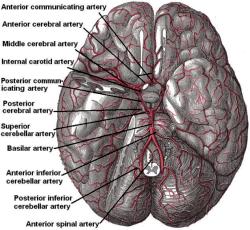Basilar artery
The basilar artery is one of the arteries that supplies the brain with oxygen-rich blood.
Anatomy
The basilar artery arises from the union of the two vertebral arteries at the boundary between the medulla oblongata and pons. Therefore, it refers to the entire service area as vertebrobasiläres basin. On average, it has a length of 3 cm, a diameter of 3 mm and runs through the cisterna pontis rostrally. Here it is in the basilar sulcus, which is formed by the localized either side of him beads of the pyramidal tracts and can be found in the middle of the pons .. At the front edge of the bridge or in the interpeduncular fossa, it divides into the two posterior cerebral arteries. This division is here generally equal to the dorsum sellae .. In their course they are for the supply of the cerebellum ( cerebellum) first the anterior inferior cerebellar arteries (clinical jargon: AICA ) and just before the superior cerebellar arteries that their distribution from. They also supplied with the labyrinthine artery, but often also arises from the anterior inferior cerebellar artery, the inner ear. With numerous smaller branches, called Rami ad pontem or pontine arteries, it also supplies the medial part of the pons and the medulla oblongata. The data can also according to their entry sites or service areas in medial, mediolateral and lateral branches ( Rami paramediani, Rami circumferentes breves and Rami circumferentes longi ) differ, the medial branches of the arterial blood supply to the adjacent regions of the pons, the lateral branches of the lateral Ponsabschnitte and the cerebellar peduncle medius take over.
Anatomical varieties
In old age, the prolonged artery can move and bend the pitch locus for the posterior cerebral arteries rostrally. The concave side of the bending, in most cases, is directed against the stronger vertebral artery. The diameter can vary from 2.7 to 4.3 mm .. The basilar artery can provide twice as trained as an anatomical variant may be ( " boutonniere deformity " ) as an expression of their emergence from the two vertebral arteries.
Pathology
According to their coverage areas occur basilar symptoms such as dizziness and ringing in the ears by the insufficient supply of the inner ear and the core areas of the vestibulocochlear nerve in the medulla oblongata in the case of deficiency by bleeding in the area of the artery. Likewise, paralysis and sensory disturbances may occur with ischemia in these areas and the cerebellum balance disturbances or circulatory disorders of the large ascending and descending pathways. These are often restricted to one half of the body, since usually only individual branches of the basilar artery are affected. Such circulatory problems can occur not only in vascular changes in the vertebrobasilar territory, but also in the subclavian steal syndrome.
Thrombosis of the basilar artery can cause severe forms of a life-threatening brain stem infarction, resulting in a quadriplegia ( paralysis of all limbs), severe sensory loss, swallowing disorders, and disorders of breathing. The most severe form of brainstem infarction, the locked-in syndrome, is associated with absolute immobility of trunk, limbs and head. Only vertical eye movements are arbitrary possible. This consciousness is in contrast to the vegetative state largely preserved.
Swell
- Artery of the head
- Central Nervous System
- Metencephalon










